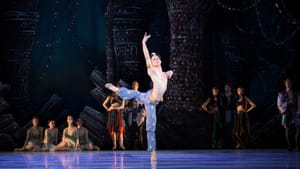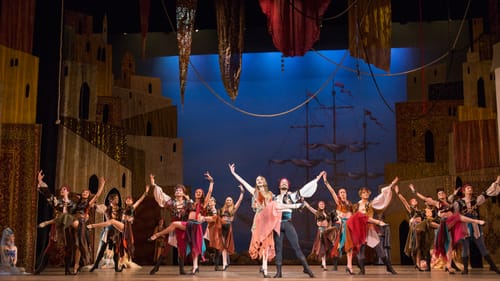Stay in the Loop
BSR publishes on a weekly schedule, with an email newsletter every Wednesday and Thursday morning. There’s no paywall, and subscribing is always free.
Dancing boys and slave girls
Pennsylvania Ballet presents Angel Corella's 'Le Corsaire'

The first time I saw the big second-act pas de deux from Le Corsaire, Mikhail Baryshnikov was dancing, so I was understandably gobsmacked. But I’d never heard of the ballet. A friend explained that the full-length ballet was never performed — I think he called it “a mess.” A few years later, in 1989, the Kirov brought a trimmed version to America. Choreographers have been trying to tame Marius Petipa’s unruly ballet — which itself derives from a Lord Byron poem — ever since. Now Angel Corella takes his shot, with some breathtaking successes, and a few “Oh no, they didn’t!” moments.
This ballet is for the boys
Le Corsaire was originally a French ballet; the Mariinsky’s Marius Petipa was born and began his career in France. But French ballet was a ballerina’s art—men served primarily to support their partners. Petipa changed ballet forever by reinterpreting those ballets with solos and pas de deux that brought male dancers to the fore. He made stars like Vaslav Nijinsky and George Balanchine possible.
This ballet is a birthday present wrapped up in a bow for lovers of male dancing, with star turns for three male dancers and some rollicking moves for a fourth. We have to celebrate Corella for judiciously trimming Petipa’s work to highlight these outrageously enjoyable bursts of masculine drama and technique. But we are still left with one of the most problematic ballet scenarios in the repertoire.
Yo ho ho
Lavish Russian-inspired sets (rented, but credited in the program to Mariinsky artistic director Eldar Aleiv) look like illustrations from a fantastic version of the 1,001 Nights: A city square of towering sand-colored structures with arched doors and windows, draped in carpets and hangings in red, gives way to a dark forest of jeweled trees, a garden of gushing fountains aglow in moonlight, and a pasha’s palace dripping with gorgeous hangings and draperies. The motley pirates’ costumes are particularly effective in an almost Jack Sparrow-ish way.
During the first act Jermel Johnson leaps across the stage with aggressive bravura as the villainous Lankendem, and the pas de deux with Lankendem and Mayara Piniero’s Gulnare is exquisite. The act ends with a rousing dance by the pirate corps. The soloists shine, but the dancing pirates were the favorites of my swashbuckle-loving heart.

Act two contains one of ballet’s most iconic pas de deux, which occurs between the hero’s servant, Ali, and rescued Medora, the tale’s love interest. Choreography here also favors a male dancer. The half-naked men who have performed it—Nureyev, Baryshnikov, our own Corella—have set hearts aflutter for decades, so Sterling Baca had some big dance shoes to fill. He’s not quite there yet, but shows promise. I particularly like his hand positions, which echo Nijinsky in some of his more “exotic” roles. I’m looking forward to seeing what he does with it the next time the company revives the piece.
Rewrite, please
I celebrate the brilliant dances for men in Le Corsaire. But it is no longer the 19th century, and if we want to keep this ballet in the repertoire, we need to address the slave girls. Act I occurs in a Middle Eastern market selling sex slaves, and each of the ballerina’s pas de deux ends with the pasha giving Lankendem, the slave trader, bags of money and receiving a girl in exchange. By Act Two, Conrad, the pirate hero, rescues his love, the slave Medora, and a group of other female sex slaves, who sit tied with ropes in the background until Medora convinces Conrad to free them. Medora, recaptured and returned to the lascivious pasha, requires a second rescue. Just in case we had not connected this frivolously sordid story to Islam, in Act Three, the pasha and the evil band of pirates, now dressed in black robes, all appear to be praying to Mecca. What was Corella thinking?
A 19th-century ballet is no place to insert a political critique of the plight of women in the world or of Islamophobia. But it is not hard to fix this. Keep the frivolity—the dances, the music, the sets, the pirates, the rescues. But don’t have money change hands onstage. Make the dancers street performers and the pasha a villain. In Act Three, free the pasha’s captives and end it with a happy dance. Or, you know, with everybody dead in the struggle. But nix the sleazy sex slavery, please.
What, When, Where
Le Corsaire. By Angel Corella (after Petipa); music by Adolphe Adams. The Pennsylvania Ballet. Through March 19, 2017, at the Academy of Music, 240 South Broad Street, Philadelphia. (215) 893-1999 or paballet.org.
Sign up for our newsletter
All of the week's new articles, all in one place. Sign up for the free weekly BSR newsletters, and don't miss a conversation.

 Camille Bacon-Smith
Camille Bacon-Smith